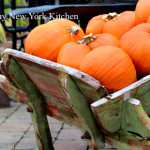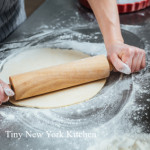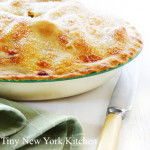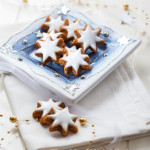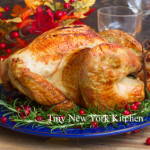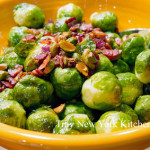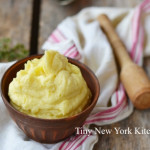Pumpkins range in size from small, creamy white specimens to giant orange globes. Ever so useful as autumnal décor, pumpkins are a versatile and vital source of healthy nutrition.
This festive fall fruit offers a rich source of vitamin C and potassium, both of which may be effective at lowering the risk of heart disease, as well as normalizing blood pressure. The brilliant orange hue of many pumpkin varieties is the result of an abundance of beta-carotene, an antioxidant that transforms into vitamin A in the body. This vitamin may have an effect on boosting the efficiency of immune systems, as well as helping to repair free radical damage to cells.
Pumpkin adds a fabulous, smooth, silky texture and unique flavor to risotto, soup, muffins, cakes, breads, stews, chili, pasta, shakes and so much more. Fresh pumpkin is delightfully delicious and contains an added bonus; pumpkin seeds! Also known as pepitas, roasted pumpkin seeds are lightly crunchy, little gems that are a potent source of zinc, which may be helpful in promoting prostate health.
Pumpkin seeds also offer a significant amount of magnesium, phosphorous, copper, iron, manganese, and omega-3 fatty acids, which may help relieve symptoms of high cholesterol, depression, high blood pressure, and arthritis.
“Work With What You Got!”
© Victoria Hart Glavin Tiny New York Kitchen © 2017 All Rights Reserved
Whether you’re baking summer pies or getting ready for holiday baking it’s important to have some key information about pie dough.
Blind Baking
Blind baking is prebaking a crust before you add an unbaked or especially wet filling. To ensure that your crust turns out crisp while blind baking, you can either dock it or use pie weights.
Docking
Docking is pricking the dough all over with the tines of a fork. The tiny holes allow steam to escape, so that the crust doesn’t puff up. After rolling out your dough and pressing it into the pan, gently prick it, leaving an inch or two between each mark. Be sure to check your crust several times throughout its bake time. If you notice it puffing up in any way, simply prick the puffy spots a few times and keep baking.
Pie Weights
Pie weights are tiny ceramic or metal balls or a thin metal chain that prevent the bottom of your crust from forming air pockets and bubbling up while baking. While docking is less fussy than using pie weights, I prefer pie weights because of the additional support they give the crust. Line your unbaked crust with parchment paper or aluminum foil before adding the weights to keep them from baking into the dough. I prefer parchment paper because its permeable structure allows the crust to breathe and brown more evenly. If you don’t own pie weights, dried beans work just as well.
Blind Bake Ahead
You can blind bake a crust up to three days ahead of time. Allow the crust to cool completely in the pan, wrap with plastic wrap, and store at room temperature until you are ready to fill and serve.
Happy Pie Baking!
“Work With What You Got!”
© Victoria Hart Glavin Tiny New York Kitchen © 2017 All Rights Reserved
The modern day Christmas tree was developed in early modern Germany, with predecessors that can be traced to the 16th and even possibly the 15th century. Devout Christians brought decorated trees into their homes. During the second half of the 19th century Christmas trees (also known as the Yule-tree) became popular beyond Germany, at first among the upper classes. Trees were traditionally decorated with apples, nuts, and other foods. During the 18th century people began to add illuminated candles, which were ultimately replaced by Christmas lights after the invention of electrification. During the early 19th century the Christmas tree became very common in the United States due to German immigrants settling Eastern and Midwestern towns. News spread of the Christmas tree between 1850 to 1860 by “Godey’s Lady’s Book,” and soon it became a common Christmas tradition.
www.tinynewyorkkitchen.com
“Work With What You Got!”
© Victoria Hart Glavin Tiny New York Kitchen © 2016 All Rights Reserved
There are four versions of classic pie dough. 1. All butter dough has excellent flavor, but can be tricky to use. 2. Butter and shortening dough is flakier and more tender. It browns slightly faster than all butter dough, but has less shrinkage and holds its shape better during baking. 3. Lard pie dough creates the flakiest, crispiest, and most tender dough of all, but the flavor is fairly bland. This dough also has the least amount of shrinkage when it bakes and it browns more slowly. 4. Butter and lard dough has superb flavor and texture. The ratio of butter to lard or butter to shortening varies from recipe to recipe, but most call for half butter, half alternative fat.
Starting with cold ingredients are key to a flaky crust. Using ice water and cold fat (butter or shortening) is important. Chill the dough for about an hour before rolling to help prevent sticking. When the pie crust goes in the oven, the cold shortening will stay solid long enough for the crust to set, creating small pockets in between the layers of dough as it melts resulting in a flaky crust.
Minimal handling is very important in helping to achieve a tender crust. Handle the dough just enough to mix it and roll it. Proper rolling is another way to avoid excess handling. Roll the dough from the center out, lifting the rolling pin after each roll.
To avoid soggy bottom crust in your fruit pie, get the filling into the piecrust and into the oven quickly. Drain off any excess juice in the bowl before pouring it into the piecrust.
For double crust fruit pies, cut slits in the top crust to allow steam to get out. The escaping moisture will help prevent soggy crusts.
Bake your pie in the lower third of the oven since this will allow the bottom crust to become crisp while the top shouldn’t get overly browned.
To cut down on the sugar in fruit pies, mix in a teaspoon or two of baking soda to the fruit before adding any sweetener. Then start out with adding 1/4 to 1/2 the amount of sugar that you normally would. The baking soda neutralizes the acid in the fruit, which means that it needs much less sweetening.
Allow the pie to cool 2 to 4 hours on a rack to room temperature or until barely warm, before slicing to ensure that the filling is set and will not run.
Slice apples thinly for apple pie. Thick slices promote air space and create a gap between the fruit and the crust and this may lead to a soggy crust.
Cornstarch is a good thickener to use with fruit to make a filling because it does not impart its own flavor and yields the smoothest texture. It also does not thin when reheating a slice of pie.
To enjoy fresh apple pie during the winter, freeze your prepared pie filling. Just cut up and slice your apples and toss them with whatever seasonings and thickener you normally put in your pie filling. Then freeze in a greased pie pan and when the apples are hard, lift them out and wrap for long-term freezing. When you want to enjoy an apple pie, all you have to do is place the ready-frozen pie filling in a crust and bake according to the recipe.
Baking a pie with a raw fruit filling will take a little longer than one with pre-cooked filling, about an hour longer. When using a pre-cooked filling, pies bake at a higher temperature for a shorter period of time, just enough to thoroughly bake the crust and heat the filling.
“Work With What You Got!”
© Victoria Hart Glavin Tiny New York Kitchen © 2016 All Rights Reserve
I love to bake all year long, but during the holidays I’m on “baking overdrive.” To make better cakes here are some simple tips to help you with the best outcome possible.
Don’t use cold eggs. The eggs really should be at room temperature, otherwise the mixture won’t emulsify properly. If you’re short on time place eggs in a bowl of warm water for 15 minutes.
Make sure to measure all ingredients precisely. Baking is an art form, but also a science.
Position pans as close to the center of the oven as possible. If you’re placing more than one pan in the oven, they should not touch each other or the oven walls. If your oven isn’t wide enough to put pans side by side, place them on different racks.
If a recipe calls for 1 cup of sifted flour, then first sift the flour and then measure it. If it calls for 1 cup flour sifted, measure the flour, then sift it. It may seem subtle, but it can make the difference between a light, fluffy cake and a heavy one.
Allow at least 20 minutes for your oven to preheat. It’s best to turn the oven on before you start working on your recipe.
Avoid opening the oven door. Opening the oven door too often can make a cake fall, so use the window in your oven door to check the cake’s process when possible.
Remember that each oven heats differently. Check for doneness 10 minutes before the recipe suggests. For most recipes, a cake is ready when it starts pulling away from the sides of the pan and a toothpick inserted in the center comes out clean.
Invest in wire cooling racks. Cakes cool faster and don’t get soggy when set out on a rack. Leave them in the pans for 10 to 15 minutes before unmolding, and then place on a rack to cool completely before frosting. Angel, chiffon and sponge cakes should be left in the pan to cool to prevent collapsing.
Unfrosted cakes can be stored, well wrapped in plastic, at room temperature for 24 hours. If storing unfrosted cakes for more than 24 hours, it is best to freeze them rather than refrigerate them. Wrap the layers in plastic wrap and then heavy-duty foil to freeze, let cake thaw in the refrigerator before frosting.
To store frosted cakes, keep at room temperature under a cake dome or large bowl unless the recipe specifies refrigeration.
For smooth and easy cake removal, prep your pans properly. When a recipe calls for greasing and flouring, place a piece of parchment or waxed paper on the bottom of a pan (trace and cut it to fit). Coat the sides and bottom with softened butter, and then dust with flour, turning the pan on its side to get full coverage and tapping out the excess. For chocolate cakes, swap in cocoa powder for flour.
Angel, chiffon, and sponge cakes should go into clean, untreated pans since they need to adhere to the sides in order to rise properly.
Happy Baking!
“Work With What You Got!”
© Victoria Hart Glavin Tiny New York Kitchen © 2016 All Rights Reserve
Remove Turkey From Refrigerator At Least 1 Hour Prior To Roasting.
Preheat Oven To 325 Degrees.
Place Turkey In Sink And Remove Neck & Giblets.
Place In Roasting Pan And Brush With Melted Butter. Season With Salt & Pepper.
Place Turkey In Lower Third Of The Oven And Roast For 10 Minutes Per Pound.
To Determine If Turkey Is Done, Place Thermometer Between Thigh & Breast. Temperature Should Register Between 160 To 165 Degrees And Juices Should Run Clear.
When Turkey Is Done, Remove From Oven, Cover Loosely With Foil, And Allow To Rest 30 To 45 Minutes, Which Allows Time To Heat Side Dishes.
Carve & Enjoy!
Approximate Cooking Times Based On 10 Minutes Per Pound At 325 Degrees:
9 Pound Turkey: 1 1/2 To 1 3/4 Hours
12 Pound Turkey: 2 To 2 1/4 Hours
14 Pound Turkey: 2 1/4 To 2 1/2 Hours
16 Pound Turkey: 2 1/2 To 2 3/4 Hours
18 Pound Turkey: 3 To 3 1/4 Hours
20 Pound Turkey: 3 1/2 To 3 3/4 Hours
22 Pound Turkey: 4 To 4 1/4 Hours
25 Pound Turkey: 4 1/4 To 4 1/2 Hours
If You Have Stuffed Your Turkey Then Add More Time.
“Work With What You Got!”
© Victoria Hart Glavin Tiny New York Kitchen © 2016 All Rights Reserved
Brussels sprouts have a pronounced and sweet nutty flavor, quite unlike cabbage, although the two are closely related. They are traditionally served at Thanksgiving and Christmas and have an affinity with certain nuts, such as almonds, pistachios, and chestnuts. Brussels sprouts taste great with onions, and ginger, or with nuts.
Brussels sprouts should be small and hard with tightly wrapped leaves. Avoid any that are turning yellow or have loose leaves. They will keep in a cool place or in the salad drawer of a refrigerator for several days.
When preparing and cooking Brussels sprouts trim away the base of the stalk and remove the outer leaves. If the sprouts are large, cut them in half or quarters, or slice thinly for stir-frying. Cook very briefly in small amounts of fast-boiling water. Alternatively, stir-fry with onions and ginger, in a little oil and butter.
“Work With What You Got!”
© Victoria Hart Glavin Tiny New York Kitchen © 2016 All Rights Reserved
Old-School Mashed Potatoes
Mashed potatoes are as American as Thanksgiving itself. Variations range from sriracha to pumpkin spice foie gras mashed potatoes (I wouldn’t recommend that latter). At Thanksgiving, nothing beats a well-made bowl of classic mashed potatoes, however. As with many other deceptively simple dishes, there are reasons why sometimes you have good mashed potatoes, and other times you have fabulous mashed potatoes. Here are my well-kept secrets to make those fabulous ones, served piping hot, and ready for that giant ladle of gravy.
Potatoes with a high starch content (the kind used for baking) provide the traditional flavor and texture. The same starch that gives a baked potato its fluffy interior also contributes to perfect mashed potatoes. Yellow-fleshed varieties like Yukon golds or yellow Finns are excellent as well, but they turn out the same color as mashed turnips, which may be disconcerting to potato purists. If you live near a farmers’ market, take the potato farmers’ advice on local favorites as they may suggest an interesting heirloom variety that will become your favorite.
Purchase your potatoes about a week ahead of time and age them in a cool, dark place. Do not place them in the refrigerator. Mature potatoes are drier and mash up lighter. Please don’t let them sprout eyes, though.
Make mashed potatoes just before serving. Reheated mashed potatoes leave me shivering.
Make sure not to overcook the potatoes. They should just yield to a sharp knife when pierced. If the drained potatoes seem soggy, just return them to the pot and cook over a low heat for about 2 minutes, stirring constantly until they begin to stick to the bottom of the pot. Doing this forces the excess steam out of the potatoes and dries them out.
Mash the drained potatoes in the still warm cooking pot with HOT milk. A cold bowl and cold milk make for lumpy and lukewarm potatoes. The precise amount of milk is a matter of taste, so use more or less to reach your desired consistency.
You’ll need an efficient mashing utensil. Some cooks swear by a potato ricer (which does make the smoothest potatoes by the way), as long as you enlist another pair of hands to make the job go quickly. You may use an electric hand mixer. If you want to use a low-tech, old school hand potato masher, go to a restaurant supply store and get a big one, or the job will take forever. The potatoes will be cooling off by the second and we don’t want that happening. Never ever mash potatoes in a food processor or you’ll get starchy, sticky, gummy mashed potatoes that could be used for gluing kindergarten craft projects.
Season well with salt and pepper. Use your taste to determine amounts. I use kosher salt mostly, but you may use your favorite type of salt. White pepper is spicier than black pepper, but will give you pristine looking mashed potatoes. But, of course, use black if you want to.
www.tinynewyorkkitchen.com
“Work With What You Got!”
© Victoria Hart Glavin Tiny New York Kitchen © 2016 All Rights Reserved

